How to memorise essays and long responses

Lauren Condon
Marketing Specialist at Atomi

When it comes to memorising essays or long responses for your exams, there are three big things to consider.
- Should you even try to memorise an essay?
- Do you know how to adapt your memorised response to the exam question?
- How on earth are you meant to memorise a 1,200 word essay??
It’s a lot to weigh up but we can help you out here. If you want an answer to the first question, here’s one we prepared earlier. But wait, there’s more! If you’re super keen to read more about question #2, then go ahead and click here .
And for that third point on how to actually memorise a long essay? Well, all you have to do is keep reading...

1. Break it down
Your essay/long response/creative writing piece could be anywhere between 800 and 1,200 words long. Yeah… that’s a lot. So when it comes to memorising the whole thing, it’s a lot easier to break the answer down into logical chunks and work on memorising it bit by bit.
So if you want to memorise your Discovery Essay, you might have something like this:
- Introduction
- Theme 1 with the assigned text
- Theme 1 with the related text
- Theme 2 with the assigned text
- Theme 2 with the related text
You’re going to want to memorise the paragraphs and pay attention to the structure then you can piece it all together in the exam. Having a killer structure makes it a lot easier to remember the overall bones of this situation and if you’re finding this effective, you can even break those body paragraphs down further like topic sentence > example > explanation > connection to thesis.
2. Use memory tricks
Now, there are lots of different strategies and approaches when it comes to memorising a long piece of writing. Moving in sections, you can try reading it out loud over again (slowly looking at the paper less and less) or the classic look-cover-write-check approach. If you’re really struggling, make some of your own flashcards that have the first sentence on one side and the next sentence on the back so you can test your progress.
You could also enlist the help of some creative mnemonics (memory tricks) to remind you which sentence or section needs to come next. Pick one keyword from each sentence in the paragraph and turn them into a silly sentence to help you remember the structure of the paragraph and to make sure you don’t forget one of your awesome points.
3. Play to your strengths
Not all of us are super geniuses that can just read an essay and then memorise the entire thing but we’re all going to have our own strengths. There’s going to be something whether it’s art, music, writing, performance or sport that just ‘clicks’ in your brain and this is what you want to capitalise on. So for me, I was really into debating and public speaking (hold back the jokes please) and was used to giving speeches and remembering them. So whenever I wanted to memorise a long response, I would write out the essay onto palm cards and then practice it out loud like a speech. Did it annoy my family? Yes. Was I too embarrassed to tell people my strategy? Yes. Did it work? Absolutely. 💯
Whatever your strengths are, find a way to connect them to your essay and come up with a creative way of learning your long response that will be much easier and more effective for you!
4. Start early
So you know how there’s that whole long-term/short-term memory divide? Yeah well that’s going to be pretty relevant when it comes to memorising. You’re going to have a much better chance of remembering your long response if you start early and practice it often, instead of trying to cram it in the night before… sorry.
The good news is, you still have a couple of months before the HSC so try to get your prepared response written, get good feedback from your teachers and then make it perfect so it’s ready to go for the HSC. Then, the next step is to start memorising the essay now and test yourself on it fairly regularly all the way up to your exams. This way, you have plenty of time to really lock it deep into your memory.
5. Test yourself
The final and maybe even most important step is to test yourself. And not with flashcards or the look-cover-check-repeat anymore. Once you’ve got the essay memorised pretty well, you want to spend the weeks coming up to HSC doing past questions so you can practice
- Having the essay memorised
- Being able to recall it under pressure
- Adapting it to any question so that all your hard work will actually pay off
For this to work, you really need to commit 100% to exam conditions (no cheating!) and it’s definitely worth sending those responses to your teacher to get them marked. That way, you will actually know if you’re doing a good job of remembering the core of your argument but also tailoring it perfectly to the question.
Any subject with essays or long responses can be super daunting so if you want to have a pre-written, adaptable response ready to go then it’s worth making sure you can actually memorise it for your exam. Remember to break down the essay into sections, play to your memory strengths and make sure you consistently test yourself all the way up to HSC. That should do the trick. 👌
Published on
July 28, 2017
Recommended reads

How to make a personalised study timetable

How to use Atomi’s 2023 study plans and timetables

Why you need a study plan ahead of your exams
What's atomi.
Engaging, curriculum-specific videos and interactive lessons backed by research, so you can study smarter, not harder.
With tens of thousands of practice questions and custom revision sessions, you won’t just think you’re ready. You’ll know you are!
Study skills strategies and tips, AI-powered revision recommendations and progress insights help you stay on track.
Short, curriculum-specific videos and interactive content that’s easy to understand and backed by the latest research.
Active recall quizzes, topic-based tests and exam practice enable students to build their skills and get immediate feedback.
Our AI understands each student's progress and makes intelligent recommendations based on their strengths and weaknesses.

How to Memorize Fast (and Why Most Memorization Tips Suck)
It's not too difficult to learn how to memorize fast and easily – if you use the right strategies, that is.
But most people don't use the right strategies.
In fact, most people don't use any strategy – they use a few tactics that don't work very well. So, let me be straight with you: If you've been using flashcards or repetition to try to drill things into your brain, you're making things difficult for yourself.
It's time to work smarter, not harder .
Here's the thing: Your mind is a supercar that you haven't figured out how to drive yet. With practice, you can learn how to memorize anything – whether it's a new language, speech, or answers to an upcoming exam.
Oh, and learning how to memorize fast doesn't have to suck, either – it can even be fun. For real. This guide will show you how to memorize fast and easily – the smart way.
Start selling online now with Shopify

6 Tips on How to Memorize Fast and Easily
If you want to learn how to memorize things fast and easily, you need to be strategic. Here are six tips on how to memorize fast that you'll learn about in this article:
- Understand your learning style
- Learn the 3 'R's of memorization
- Practice the substitution method
- Learn the story and link method
- Use the memory palace method
- Apply spaced repetition strategically
Step 1. Understand Your Learning Style
Before you try to learn how to memorize fast, it can help to have a basic understanding of how you best interpret and absorb new knowledge.
Now, there are four main learning styles usually referred to by the acronym "VARK":
- Reading/writing
- Kinesthetic
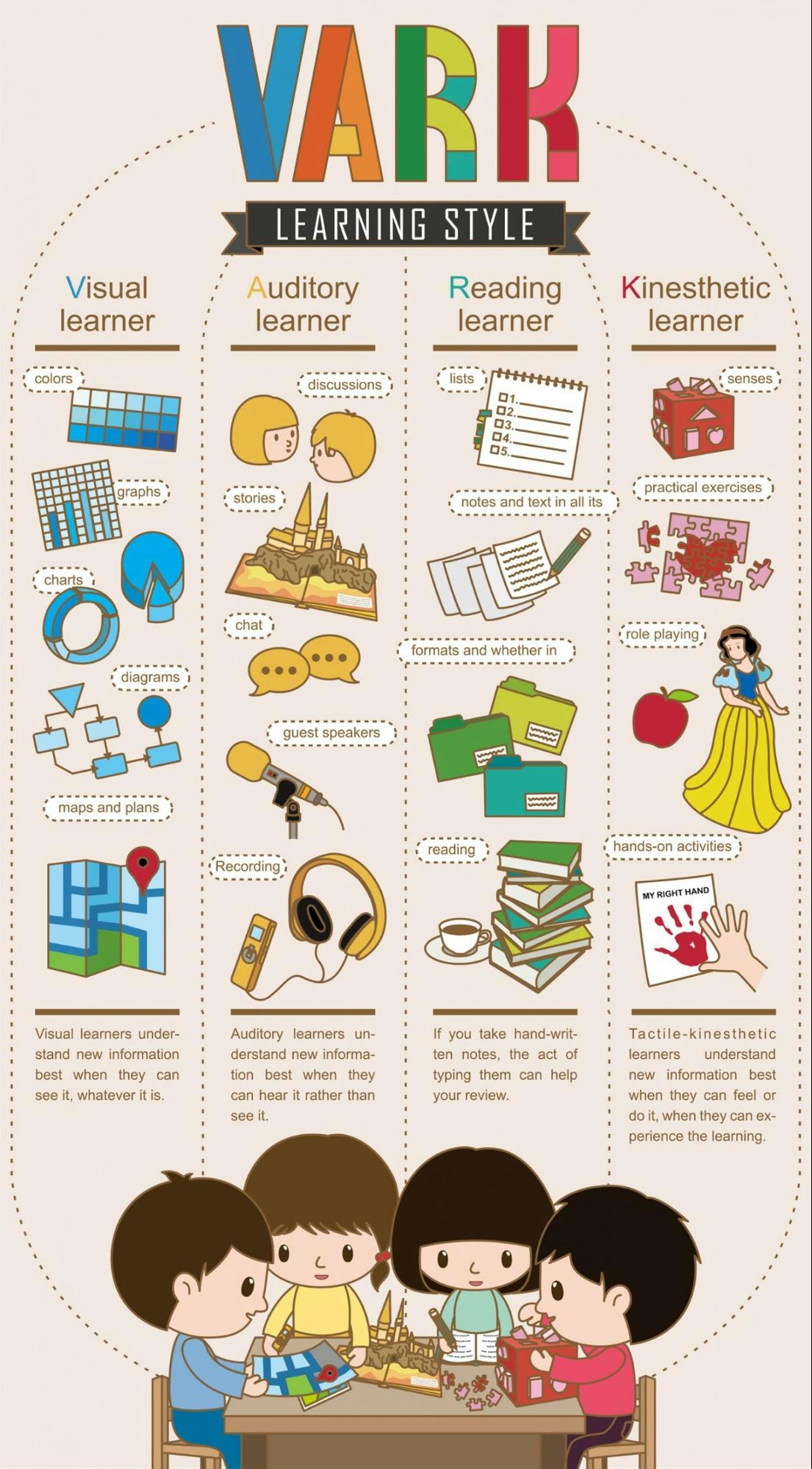
Let’s take a closer look at each of them.
Visual learners learn best through sight. They like information to be presented visually and tend to prefer seeing and observing things, such as diagrams, pictures, and demonstrations. Many visual learners also like to sketch, draw, and write lists.
2. Auditory
Auditory learners learn best by listening and when the subject matter is communicated through sound.
They'd rather listen to podcasts , lectures, and audiobooks than read books and notes. If they have to read a book, they're likely to absorb more information if they read it aloud to themselves. Many auditory learners also like to engage in discussions.
3. Reading/Writing
Reading/writing learners prefer to learn through the written word.
They learn best when reading books and articles . They also learn well when taking and reviewing notes. This learning style overlaps with visual learning, however, these learners tend to prefer to express themselves through writing.
Traditional western education systems cater to reading/writing learners by focusing on reading books and writing essays.
4. Kinesthetic
Kinesthetic learners learn best by experiencing or doing things. They're sometimes referred to as "tactile learners."
This type of learner likes to get moving and use their hands. They excel when they can interpret the subject matter through their physical senses. They prefer hands-on exercises over book-learning every day of the week.
Which Style of Learning Do You Prefer?
It may be pretty obvious which learning style you prefer. For example, it's clear to me that I'm a visual and reading/writing learner – after all, I'm a writer.
However, if you're unsure which style – or styles – of learning you prefer, check out this VARK questionnaire to find out.
It’s also worth noting that most people have a natural preference for more than one style. Oh, and in case you were wondering, no particular learning style is better than the others. They're just different!
Step 2. Learn the 3 'R's of Memorization
It's time to understand the foundations of how to memorize fast and easily: The three 'R's of memorization.
These three steps are the strategy you need to learn how to memorize fast. Here's how they work:
- Registration: The first step is to record a new memory in your mind with the intention of storing it in your long-term memory. To learn how to memorize quickly, it helps to practice effective registration techniques.
- Retention: In this stage, you work to retain the information in your brain and move it from your short-term memory into your long-term memory so that you can recall it later.
- Recall: In the final stage of memorization, you can use techniques to retrieve the information stored in your mind.
People refer to these steps in different ways – for example, some people call them "encode, store, and retrieve" – but the basic principles are the same.
Most memorization tips miss one or more of these steps.
For example, repetition can help with retention. However, reading something over and over does nothing to encode the information into your mind intentionally. Plus, it provides no mechanism that you can use to recall the information.
In short, to learn how to memorize faster, you need to use all three 'R's.
Step 3. Learn How to Memorize Fast and Easily
Now that you have the basics under your belt, it's time to learn how to memorize something quickly. So, what is the easiest way to remember something?
The best way to memorize things is to use a mnemonic device – which is just a fancy way of saying a memory device.
What is a mnemonic device?
Simply put, a mnemonic device is anything that helps you to remember something. For example, the phrase "'I' before 'E,' except after 'C'" is a mnemonic device.
Here's an example of a visual mnemonic device to help remember the numbers of days in the months, with each knuckle representing a 31-day month:
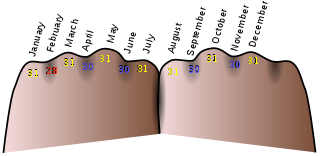
Whenever you hear about 'memory athletes' that can recall the order of six decks of playing cards, they're using mnemonic devices.
It's not magic. It's just practice, and you can do it too.
There are countless mnemonic devices out there. However, we're going to focus on three of the most popular and effective techniques that you can use to learn how to memorize something faster.
Unlike repetition and flashcards, each of these mnemonic devices uses the three 'R's of memorization – registration, retention, and recall.
1. The Substitution Method
This first memory method is super simple. All you need to do is take what you want to remember and substitute it for something more memorable.
For example, say that you're trying to memorize the periodic table of elements. When trying to remember the first element, "hydrogen," you could link it to the word "hydrant" because they sound similar.
For the second element, helium, you could imagine a balloon filled with helium, and so on.
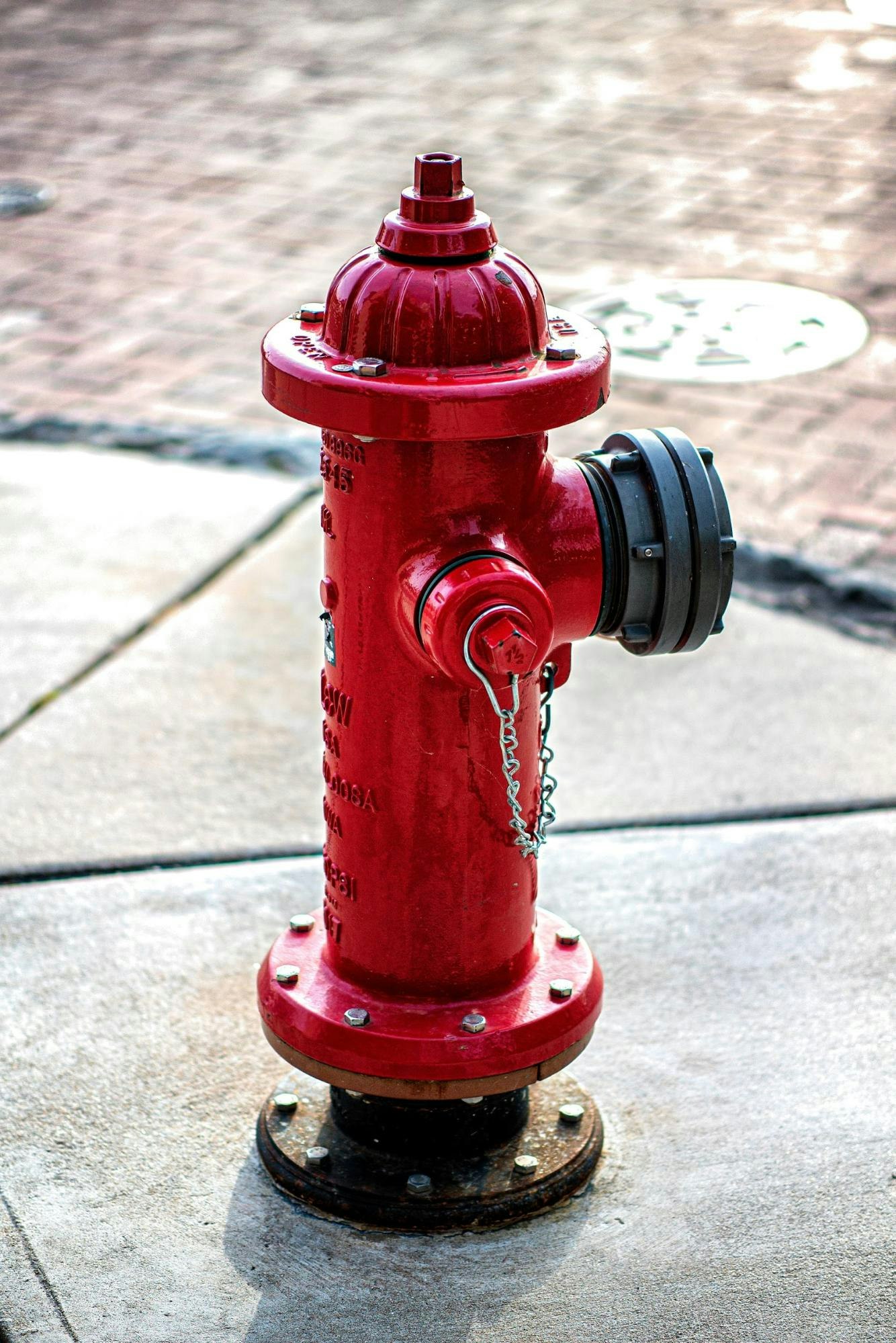
Then, consider which learning style you lean toward and use that information to help you forge a lasting connection. For example:
- If you're a visual learner, you could visualize a bright red fire hydrant on the sidewalk.
- Auditory learners could practice saying the words "hydrogen, hydrant" out loud to emphasize how they sound similar.
- Reading/writing learners could write the words down, emphasizing how their spellings are similar, with both words beginning with "h, y, d, r."
- Every time they walk past a hydrant, kinesthetic learners could touch the hydrant with their hand and practice saying the word "hydrogen" out loud.
When you need to recall the first element of the periodic table, it'll be a lot easier to remember the red fire hydrant first, which will trigger the memory of "hydrogen."
Substitution is an effective way to register new information in your brain and have a way to recall it easily later.
Plus, this technique doesn't just work with words – you can also use it to remember ideas, concepts, names, dates, or even the key talking points in a speech.
Okay, but how do you remember lots of things?
2. The Link and Story Method
Here's where things get interesting: After you've created some substitutions to memorable words and objects, you can link them together with a story.
Here's an example of how you could link "fire hydrant" (hydrogen) with "balloon" (helium):
Imagine a bright red hydrant (hydrogen) on a sunny sidewalk at a park entrance. Stood next to the hydrant at the park entrance is a vendor selling balloons (helium) to children entering the park.
Here's the trick: Exaggerate the story so it sticks in your mind more – this will help with retention and recall.
For instance, perhaps the hydrant is broken and is spraying water everywhere. Or maybe the balloon vendor is dressed as a clown. Use whatever works best for you!
Once you create effective associations and link them together with a compelling story , it becomes very easy to remember things.
This method is a great way to register large amounts of information in your mind while also providing a mechanism to recall it.
3. The Memory Palace Method
If you want to know how to memorize a lot of information, try the memory palace method.
This method has stood the test of time – it was first presented in a book called the "Rhetorica ad Herennium," written in 80 B.C. by an unknown author.
Here’s how to use it:
- Think of a place or a journey you know well, such as your home or a daily commute.
- Identify some significant points in your home or on your commute .
- Link what you want to remember to each one of those points.
For example, say that you need to remember a speech.
You could break your speech up into points, such as your introduction, three main talking points, your summary, and final thoughts. You can then link each of these points to something in your memory palace.
Your home's front door could represent your speech's introduction. Then, your three main talking points could be the living room, kitchen, and bathroom. The summary may be the hallway leading out of the house, and your final thoughts could be the front yard.
Then, whenever you practice your speech, you can imagine walking around your house for each point.
If you have a long speech – or a large amount of information to remember – you can break the information down into smaller chunks and link them to things in each room.
For example, say you have three aspects in your first talking point (the living room). You could link each one to a piece of furniture, such as the sofa, coffee table, and standing lamp.

If you practice the memory palace method, you should be able to walk around your house – or run through your commute – in your mind and recall all of the information.
Again, this method hits all three 'R's by providing a way to encode, retain, and recall information.
Step 4. Apply Spaced Repetition
Once you've registered new information in your mind, how can you stop yourself from forgetting it? Apply spaced repetition.
Way back in 1885, Hermann Ebbinghaus created the 'Forgetting Curve.' This concept demonstrates how we forget things. Simply put, as soon as we learn something, it starts to fade from our memory.
However, we can prevent this decline by reviewing the information periodically. When we do this, we can increase the strength of the memory.
If you're a visual learner, here's what it looks like:
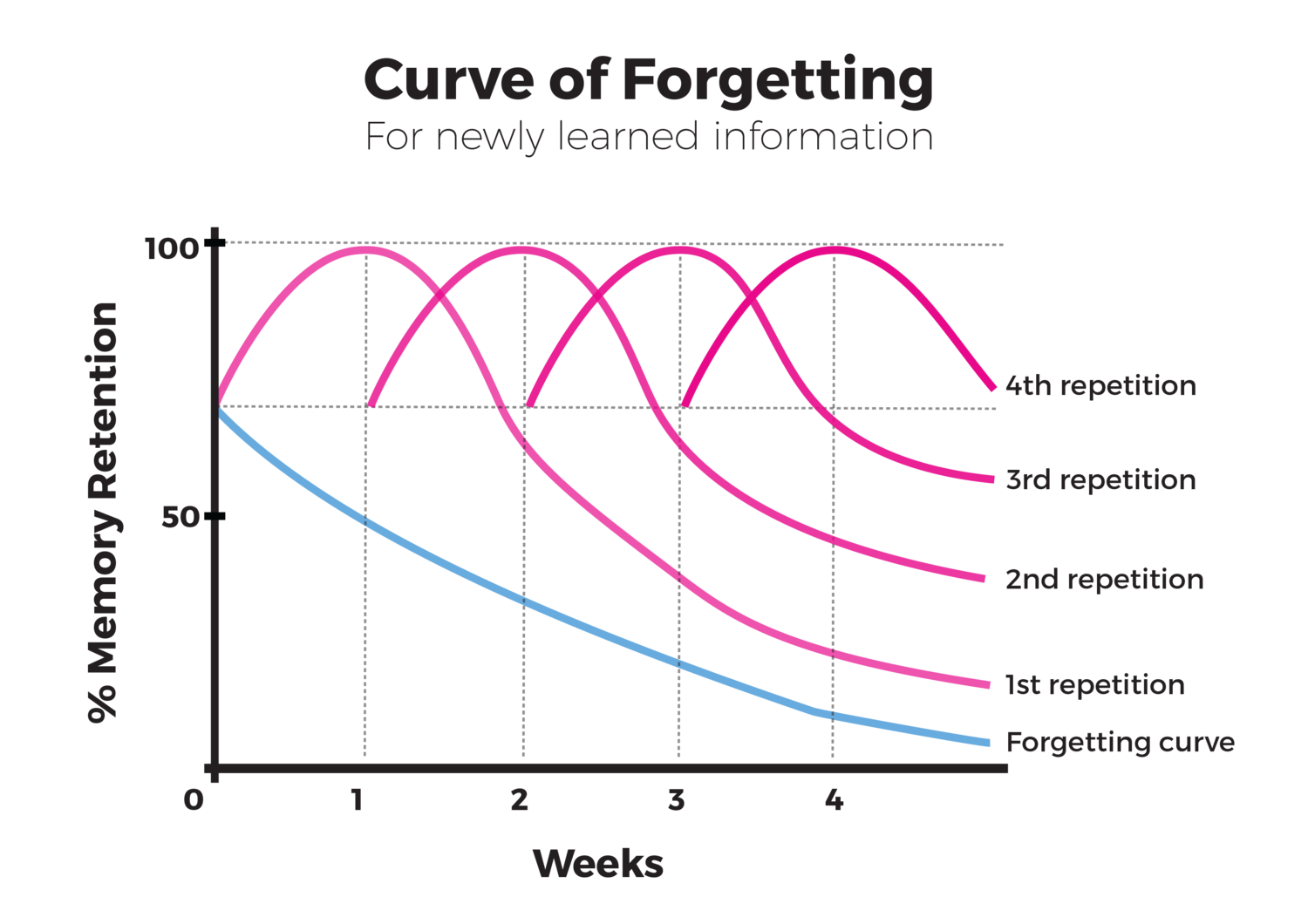
So, when should you review the subject matter?
At first, it helps to review things often – for example, you may want to review something daily at first, then bi-weekly, and then weekly until you're confident you won't forget it.
Again, look to your preferred learning style to help you. For example:
- Visual learners could draw a storyboard or sketch their memory palace.
- Auditory learners could tell their story aloud or describe walking through their memory palace.
- Reading/writing learners could write their story down and review it regularly.
- Kinesthetic learners could act out the story or walk through their memory palace in real life.
You may also want to review material late in the evening before bed.
Why? Studies show that people who study before bedtime can often remember more of what they learn a day later. Plus, they also felt more confident about their answers.
Summary: How to Memorize Quickly
If you want to learn how to memorize fast, repetition alone won't cut it – you have to be strategic.
Start by identifying how you learn best. Are you a visual, auditory, reading/writing, or kinesthetic learner?
Then, understand the three 'R's of memorization (registration, retention, and recall) and put them to work:
- First, encode the information in your mind using a mnemonic device, such as the substitution method.
- Link this information to a story or memory palace to ensure you can easily recall it later.
- Practice spaced repetition to combat the forgetting curve and retain the information.
What are you trying to learn? What is the best way to memorize something for you? Let us know in the comments below!
- How to Train Your Brain for Success: 7 Mind Training Tactics
- How to Stop Procrastinating Now: Everything You Need to Know
- Entrepreneurial Mindset: 20 Ways to Think Like an Entrepreneur
- How to Start a Productive Morning Routine for Success (Proven Method)

How To Be Successful in 2024: 10 Tips To Win Big
Want to learn how to be successful? We’ve got a formula: Stop Looking for the Silver Bullet | Start Creating Better Goa…

27 Hobby Ideas: Budget-Friendly & Fun To Try in 2024
Are you looking for hobby ideas that are fun and don't cost a pretty penny? Here are 27 that will leave you healthier a…

How To Make Money on YouTube: 9 Top Tips
Want to learn how to make money on YouTube? Good idea. YouTube offers tons of opportunities to convert views into cash—…
Oberlo uses cookies to provide necessary site functionality and improve your experience. By using our website, you agree to our privacy policy.
How To Study: The Essay Memorisation Framework

Join over 620,000 readers enjoying 💌 Sunday Snippets - my free, weekly email newsletter where I share what I’m reading and what I’ve learned in the worlds of productivity, business and life.
As a medical student, I did have to undertake some exams that required writing essays. One of the questions I often get asked is how you can apply techniques such as active recall and spaced repetition – that I frequently discuss as being ‘the best’ revision techniques – to essay-based subjects. During my third year at university, I adopted the following approach to preparing for my own essay-based psychology exams – it proved highly effective in my own exams and I hope that you can make effective use of it too.
The system can be broadly broken down into two stages:
- The Creation Stage
- Objective to create first class essay plans for every conceivable essay title that they throw at us in the exam.
2. The Memorisation Stage
- Objective of committing all of these essay plans to memory by systematically using active recall, spaced repetition, spider diagrams and flashcards.
The idea is that, by using these two stages, by the time the exams arrive you’ll have memorised so many essay plans that they will either come up in the exam or the essays will be similar enough that you will have the knowledge to draw up and form coherent and well-structured essay that answer the question effectively.
Creation Stage
There are three main questions in the creation stage:
How to decide what essay titles to pick/prepare
The objective here is to ‘scope the subject’ and find essay titles that cover the entire breadth of the syllabus. The easiest way to do this is to both look through the past papers and start by planning the essays that have come up in the past and then examine the syllabus and identify areas that lend themselves to essays. Once you’ve planned out those essays, you’ll have a better idea as to what style of questions are asked and what material is often covered. This should give you a breadth of essays titles that span the course – if you find that there is still an area of the syllabus that hasn’t been address, try to come up a suitable question and add it to your essay plans to compile.
How you plan the essay
Personally, I would give myself one day per essay plan. Although it’s best to try to have this process ongoing throughout the year, I did the bulk of my essay plan preparation in the Easter holidays (perhaps not ideal!).
My process involved starting off with a question then use Google to get as much information as possible about that particular topic. I would start off with Google because it can give you a good broad overview as well as useful links to review papers that would often provide key details or interesting examples.
Once I had created my essay plan I would then look at the lecture notes and the recommended reading. This meant that a lot of my material was more original than everyone else’s because most other people would’ve built their essays based around the lecture notes, whereas I was building my essays from a Google search supplemented by lecture notes.
Once I had got my research document, I would spend a few hours writing out the essay – consolidating all the information into this one essay that I am ultimately going to learn.
How you make sure your essay plan is really good.
But how do we make an essay plan good? There are 3 key ingredients in my opinions:
- Answering the question
- Adding a bit of spice.
The introduction is the most important part of the essay because you can address all three of these key ingredients and signal to the examiner how you are going to go about compiling the essay and answer the question.
Here is an example of one of the introductions from an essay that I prepared on whether judgement and decision making is cognitive (logical) or affective (emotional).
The historical view in the social sciences has always been that judgements are based solely on content information, with individuals being assumed to form judgements by systematically evaluating all available content information in an unbiased manner. However, over the past three decades a considerable amount of research has challenged this assumption by showing that judgments may be formed not only on the basis of content information (cognitive judgements) but also on the basis of feelings (affective judgement). It is now well accepted that judgement can be both affective and cognitive. Whether it is one or the other depends on a multitude of factors: (1) the salience of the affective feelings, (2) the representativeness of the affective feelings for the target, (3) the relevance of the feelings for the judgement, (4) the evaluative malleability of the judgement and (5) the level of processing intensity. I will discuss these in turn and ultimately argue that generally speaking in day-to-day life, the circumstances are generally those that result in affective rather than cognitive judgements and decision making.
As you can see, I signpost the essay explicitly using numbered points as well as answering the question and outlining to the examiner the direction that my argument is going to go.
The Memorisation Stage
By this point, you should have a good number of essay plans that you’ve created in documents – now the aim is to ‘upload’ those essay plans to our brain. I approached doing this using three main techniques:
Anki Flashcards
With my essays, I used Anki flashcards to memorise paragraphs and main points whether from an essay or key points from a particularly relevant research paper. The aim was to create blocks of content with every Anki flashcard being its’ own ‘block’ which I could then draw upon either for the essays that I had planned or for unfamiliar essays but ones which I could answer using the material from the flashcards.
However, specific paragraphs or points from research papers aren’t helpful unless you can associate them with particular essays – that’s where spider diagrams come into the equation…
Spider Diagrams
Having memorised content blocks from my essays using Anki flashcards, I made one page diagrams of every single essay. The idea being that you would be able to discern the structure of the essay through the spider diagram as well as notice key words that are relevant for that topic and/or that you find particularly helpful in triggering your memory about the key points that you need to raise in answering that question.
Every day I would draw out various spider diagrams from memory and if there were any books that I didn’t know, I would look them up in the master research document or in Anki and actively work on learning those parts.
Over time, this became a highly effective way to systematically use active recall to ensure that I knew absolutely everything.
Retrospective Revision Timetable
The final part of the system involved systematic spaced repetition. If you’ve seen any of my other content, I am a big proponent of retrospective revision timetables. This approach counters the conventional idea of planning a prospective revision timetable which has a number of issues – namely trying to predict the future and inflexibility, amongst others – and instead involves creating a spreadsheet that starts with a list of subjects, topics or essays that we have compiled through scoping our subject and then inputting the dates on which we study those areas as well as colour code the system to provide a visual representation as to which areas we might need to cover again. You can read more about these sorts of timetables here , where I explain them in more depth.
This structure which combines active recall, spaced repetition, flashcards and spider diagrams was probably the most effective system that I used whilst at university. In the exam, about two thirds of the essays that we had to write, I had already planned. Although the other four essays that I had to write were ‘new’, I had built up such a systematic and in-depth knowledge of the subject that I could more easily draw upon ‘blocks’ of content from my Anki decks which I could then ‘drop’ into these essays to answer them effectively.
I hope this has provided you with a more logical structure with which to utilise active recall, spaced repetition, spider diagrams and flashcards to ensure that you can approach your essay-based exams with more confidence.
Please see the other blog posts in this ‘How To Study’ series for more hints, tips and guidance on studying and revising.
About The Author
I'm an ex-doctor turned YouTuber, Podcaster, entrepreneur and author. I've been creating YouTube videos for over 7 years and have a following of over 4 million over on my main channel.
Browse Topics
- 🚀 Productivity
- 🛠 Tools & Tech

💌 Subscribe to Sunday Snippets
"Your emails always warm the cockles of my heart"
Join a growing community of more than 620,000 (🤯) friendly readers. Every Sunday I share actionable productivity tips, practical life advice, and high-quality insights from across the web, directly to your inbox.
- PRO Courses Guides New Tech Help Pro Expert Videos About wikiHow Pro Upgrade Sign In
- EDIT Edit this Article
- EXPLORE Tech Help Pro About Us Random Article Quizzes Request a New Article Community Dashboard This Or That Game Popular Categories Arts and Entertainment Artwork Books Movies Computers and Electronics Computers Phone Skills Technology Hacks Health Men's Health Mental Health Women's Health Relationships Dating Love Relationship Issues Hobbies and Crafts Crafts Drawing Games Education & Communication Communication Skills Personal Development Studying Personal Care and Style Fashion Hair Care Personal Hygiene Youth Personal Care School Stuff Dating All Categories Arts and Entertainment Finance and Business Home and Garden Relationship Quizzes Cars & Other Vehicles Food and Entertaining Personal Care and Style Sports and Fitness Computers and Electronics Health Pets and Animals Travel Education & Communication Hobbies and Crafts Philosophy and Religion Work World Family Life Holidays and Traditions Relationships Youth
- Browse Articles
- Learn Something New
- Quizzes Hot
- This Or That Game New
- Train Your Brain
- Explore More
- Support wikiHow
- About wikiHow
- Log in / Sign up
- Education and Communications
- Study Skills
- Memorization Skills
How to Memorize Quickly
Last Updated: March 3, 2024 Fact Checked
This article was co-authored by Alexander Ruiz, M.Ed. . Alexander Ruiz is an Educational Consultant and the Educational Director of Link Educational Institute, a tutoring business based in Claremont, California that provides customizable educational plans, subject and test prep tutoring, and college application consulting. With over a decade and a half of experience in the education industry, Alexander coaches students to increase their self-awareness and emotional intelligence while achieving skills and the goal of achieving skills and higher education. He holds a BA in Psychology from Florida International University and an MA in Education from Georgia Southern University. There are 10 references cited in this article, which can be found at the bottom of the page. This article has been fact-checked, ensuring the accuracy of any cited facts and confirming the authority of its sources. This article has been viewed 1,027,858 times.
Memorizing quickly is an important talent to have. Whether for school, work or simply to improve yourself, exercising your memory adds to your capabilities as a person and helps to keep your brain healthy. The art of memorization is ancient and history is filled with clever ways of committing things to memory. By applying modern psychology, these approaches to memorization can be divided into five core methods.
Things You Should Know
- Try rote memorization; make a list of everything you need to know and repeat them until they’re committed to memory.
- Follow the chunking method, which involves organizing information into groups or categories and memorizing piece by piece. [1] X Research source
- Chain items into a single sentence made of everything you need to know or use mnemonics to create a key sentence representing what you have to memorize.
- Memorize through association by creating an imaginary journey or walk-through to associate with the facts you need to remember.
Memorizing through Association

- Memories that are easy to split up and spatially organize are best suited for the associative method - things like the stanzas of a poem, components of a machine or the procedure for cooking eggs.
- Memories that can't be divided up are less well-suited - like the basic idea of Abstract Expressionist painting, the history of the War of the Roses or remembering how to ask someone out.

- For this reason, if you have a list of discrete items that don't fit together in any way, it'll be harder to shape your second "key" memories. For our example, we'll simply imagine being a tiny little man walking around inside a 1911 slide.

- " First we'll encounter the barrel bushing, and inside it, I can see the barrel poking out. Behind the barrel and the breech face as we walk further back I'll see a tiny hole through which I can see the firing pin, and to its left will be the extractor against the side of the slide; when I make it to the very back, I'll reach the hammer stop. "

Rote Memorization

- Rote memorization is very good for manual tasks and short lists of items like a shopping list, starting a car, or ironing a shirt.
- Rote memorization is not very good for memorizing a large number of separate items or single complex ideas like the elements of the periodic table from left to right, the idea of dialectical materialism, or the components of a car engine. [5] X Research source

- At first you'll get a lot wrong - don't get frustrated! This is just your brain getting used to the work. Keep at it, and within a few minutes, you'll be able to remember everything you've memorized.

- If you've ever memorized a phone number, you might have noticed the way we write them - they're set up to be chunk-memorized. For instance, the White House phone number, (202) 456-1111 is easier to remember as three numbers - 202, 456 and 1111 - than it is to remember as a single complex number, 2,024,561,111.
- Chunking isn't a great strategy for big, complex things and concepts that don't break down into parts easily. For example, it's not easy to figure out what "memorizable" chunks would be for memorizing the concept of civil rights, the definition of nationhood or a list of similar phone numbers. [8] X Research source

Chaining Items into a Sentence or Concept

- Chaining is great for a limited number of items in an arbitrary list without any seeming relation to each other (for instance, the list tree, bird, keyboard, bottle ). It's hard to apply a strategy like chunking because there aren't any real categories to break stuff down.

- Peanut butter and espresso bean sandwich wrapped in ethernet cable with a screwdriver going through it.

- Peanut butter and espresso bean sandwich wrapped in ethernet cable with a screwdriver going through it = peanut butter, espresso beans, bread, ethernet cable, screwdriver bit
Using Mnemonics

Expert Q&A

You Might Also Like

- ↑ https://psychcentral.com/lib/memory-and-mnemonic-devices
- ↑ Ted Coopersmith, MBA. Academic Tutor. Expert Interview. 10 July 2020.
- ↑ https://blog.penningtonpublishing.com/spelling_vocabulary/how-to-memorize-using-the-association-technique/
- ↑ https://resilienteducator.com/classroom-resources/what-is-rote-learning/
- ↑ https://www.brainscape.com/blog/2011/04/rote-memorization-important/
- ↑ Alexander Ruiz, M.Ed.. Educational Consultant. Expert Interview. 18 June 2020.
- ↑ http://thepeakperformancecenter.com/educational-learning/thinking/chunking/chunking-as-a-learning-strategy/
- ↑ https://learningcenter.unc.edu/tips-and-tools/enhancing-your-memory/
- ↑ https://www.sciencebuddies.org/stem-activities/dont-forget-a-memorization-exploration
- ↑ https://psychcentral.com/lib/memory-and-mnemonic-devices/
About This Article

If you want to get better at memorizing information quickly, make a list of the things you need to memorize, then read that list several times. Try covering part or all of the list with a piece of paper until you can recite the whole thing without looking. If you have a lot of information, try breaking it up into smaller chunks, then memorizing each chunk one at a time. To learn how to create a sentence out of the items you’re memorizing, read on! Did this summary help you? Yes No
- Send fan mail to authors
Reader Success Stories
Nov 19, 2016
Did this article help you?

Shubham Mondal
Nov 2, 2020
JustJon4th4n
Jun 14, 2021
Jul 28, 2016
Aug 22, 2017

Featured Articles

Trending Articles

Watch Articles

- Terms of Use
- Privacy Policy
- Do Not Sell or Share My Info
- Not Selling Info
wikiHow Tech Help Pro:
Develop the tech skills you need for work and life
- How It Works
- Prices & Discounts
How to Write a 1000-Word Essay in One Night and Not Lose Your Calm
Table of contents
It’s Sunday night, and you just realized that you haven’t even started writing your 1000-word essay that is due on Monday. How are you going to write it in one night, you wonder.
What follows is panic as you rack your brain, wondering where and how to begin.
Writing is an art. Every word you write mirrors your thoughts and ideas on paper.
Similarly, how you express these words is a way of expressing yourself. While essay writing is not rocket science, it certainly isn’t something you should take lightly as well.
The good news is there is hope, and you can write a 1,000-word essay in one night. In this article, you will learn how.
Writing a 1,000-word Essay in One Night: 4 Preparation Hacks
Preparation is key, especially when you’re expected to write an essay at the last moment. Let’s take a look at four tips to help you prepare for the long night.
#1. Plan your time
Time management is a high priority when you have only a few hours to write your essay. Thus, use your maximum efficiency and your fullest potential to complete the essay on time.
If you plan to just sit down and start writing, you may not be able to track your progress on each interval and see which section of the essay you spent the most time on.
Hence, you should base your essay portions on specific time intervals. For example, break your time into 45 mins and plan to complete each task of the paper in that time frame.
Keep one hour spare in the end to revise, edit, add visuals, recheck arguments, proofread, or even just to read it a couple of times to check the flow of the essay.
#2. Read the prompt carefully
It is critical to read the essay prompt carefully and not miss a single detail present in it, as there might be multiple important pieces of information that are required to be adhered to for completing the essay.
Guidelines like the number of sources to use, how to format the essay according to the professor’s requirement, writing in a particular tone and style, the target audience, or even just understanding the essay topic diligently are fundamental to follow to be able to craft a quality essay without any errors.
The worst thing that can happen after writing and completing your assignment is to learn that you deciphered the prompt incorrectly, or got confused with the type of expectations your professor had for this essay assignment, and now have nothing to submit.
So, read the prompt carefully.
Here’s a useful video by Nicolas Weiss on reading essay prompts
#3. Use reliable sources for notes
As you start framing your essay, remember to refer to credible and reliable sources for your note-taking process.
Citing down your references in a bibliography is a must-needed step in your essay writing and forgetting to complete this step will bring down your grades drastically.
Having credible references and sources makes your essay seem completely thorough and well-researched, as well as gives your content more authority and authenticity.
#4. Create a rough outline of the structure
Before you begin to write your essay, build a rough outline of the important points you need to take note of, the short forms that will be used in the content, and the basic structure of your essay.
It’s important to also note down how you will introduce your essay , your thesis statement, all the points that have to be added in each paragraph, and the evidence that supports these claims.
A well-written outline gives the essay a structured flow, organized points, and no extra fluff, and makes it easier for the readers, or in this case, your professors, to read and understand your essay easily.
Additionally, the outline also helps the writer to not forget important points and arguments that were to be made in the essay.
Here’s How You Can Write a 1,000-word Essay in One Night
Now that we know that preparing before executing is highly primal when, you have to write your essay in one night. Let’s see how we can write a 1000-word essay in one night and do a good job at it.
Write in an appropriate environment
Usually, people don't think too much about the space in which they sit to work . But this is a very important step for writers to take care of to execute flawless and organized pieces of writing.
To write quality articles, blogs , essays, etc., choose an appropriate, peaceful, and distraction-free environment.
Create a mood around you where you are motivated to work so that you can hear your thoughts and express them in words, as well as come up with ideas that can be written down in the best way.
A library or a study nook at your home is the best place to concentrate thoroughly on writing assignments. Switch off your phone, log out of your social media, grab a cup of your favorite beverage, focus on your approach, and write away.
Create an effective plan
It is very important to have a plan to succeed in a task without any complications or errors. Having an effective and smart plan will make any challenging, confusing, or complex task more organized , thorough, and easy to execute.
So, before you begin your essay, think of the following topics, and plan out your entire process of writing the essay:
- The word limit or essay length ;
- Creating the thesis statement;
- Major topics and points to be covered in the essay;
- A basic outline of the essay’s structure;
- Examples, references, evidence to cite;
- Images, GIFS, infographics, or videos to embed (if needed);
- Suggestions and recommendations.
Once you plan out your essay by having the answers to all these questions, it becomes much easier to frame the entire essay in a short time.
Do thorough research for your essay
Writing a 1000-word essay for your assignment without doing any full-fledged research on your topic, will just nudge you into failure.
Researching to write content that is fresh, informative, and credible is the only way that your professor will deem your essay as a quality piece of writing. Furthermore, you need data and references to back all your arguments and claims.
For example, when you research a topic, you come across multiple sites and reliable sources where you can take out necessary information and data to frame your essay.
As you go further, when you start writing down your points and details that make the content of your paper, you might need to go back to your references sometime or other for help or confirmation.
Place realistic and attainable goals
Don't think about trying to finish your essay in 30 minutes. It is going to end up being poorly executed, with no flow or organized arguments.
Additionally, you would probably have an essay riddled with silly spelling mistakes and grammatical errors that could have been avoided if you took advantage of the entire time you have on your hands to work on drafting a perfect, well-researched, top-quality essay.
Aim for realistic and achievable targets that can be accomplished by you. Sort of a specific time frame to complete the task you’ve assigned yourself for each of these intervals. Take a short break after finishing major portions of your essay, to avoid being stressed or overburdened.
Never forget to edit and proofread
Never leave proofreading your essay as a last resort. It shouldn’t be something that you will only do if you have enough time and energy after working on the entire essay.
Proofreading is a must because when you revise and re-read your essay, you will end up finding mistakes or slip-ups that you could have made while writing in a hurry.
These slip-ups would eventually bring down the entire purpose of writing the essay and decrease your chances of getting a good grade. That is why, resolving these issues after proofreading is critical, to laying out a perfect and flawless essay assignment.
Ideally, you should plan out your essay in such a way that there is enough time, in the end, to revise and edit, wherever necessary.
In conclusion, it is best not to panic and rush the process since writing your essay assignment in one night with a composed head will help immensely in thinking straight and completing a great paper.
Furthermore, use these practical tips and tricks to get the best results out of our guide to write a 1000-word essay in one night and not lose your calm.
If you’re unable to concentrate and need urgent essay writing service , we’re glad to assist. Writers Per Hour’s team of urgent essay writers knows what it takes to write essays quickly without compromising on quality.
So, before you lose your calm, write to us and let our professional essay writers write your 1,000-word essay in one night and help you get the grades you desire.
Share this article
Achieve Academic Success with Expert Assistance!
Crafted from Scratch for You.
Ensuring Your Work’s Originality.
Transform Your Draft into Excellence.
Perfecting Your Paper’s Grammar, Style, and Format (APA, MLA, etc.).
Calculate the cost of your paper
Get ideas for your essay
How To Write A Five Paragraph Essay In One Hour
You have a short deadline. You feel like you can’t write your essay fast enough, you’re asking, “Can I write my essay in one hour ?”

Writing an essay can be daunting, especially when you only have one hour to complete it. But never fear. With careful planning and a few simple tricks, it is possible to write a five-paragraph essay in one hour. This article will provide you with the necessary tools and information to help you create an effective, well-structured essay in a single hour. We will discuss the basics of essay organization, time management strategies and tips for improved writing quality.
Table of Contents
5 Main Types Of Essays
The writing process can be made easier with a clear understanding of the five main types of essays. Knowing and mastering these five types will help you create persuasive, well-crafted pieces that will impress your instructors and earn you top grades. This article will explore each type of essay in detail and provide insights into when and how to use them effectively.
Type 1: Argumentative
An argumentative essay is a type of writing that presents arguments to support a particular opinion, point of view or perspective. It is commonly used in academic writing and it requires the writer to provide evidence for their opinion or point of view. The main purpose of an argumentative essay is to convince the reader that their opinion is correct.
In order to write an effective argumentative essay, it is important to research both sides of the issue thoroughly and present facts and evidence in a logical manner. When writing an argumentative essay, it is important to remember that your goal should be convincing the reader that your viewpoint is valid and supported by facts. Furthermore, a successful argumentative essay will include counterpoints that are refuted with sound reasoning and solid evidence.
Type 2: Narrative
Narrative writing is a type of writing that tells a story. It usually follows a plot format that includes characters, setting, conflict, and resolution. Narrative writing can be used to present an argument or to tell a personal story. It has been used for centuries in literature and can also be found in many forms today such as movies, plays, and even video games. When writing a narrative essay, it is important to use descriptive language to draw the reader into the story. The author should create vivid images through their words while focusing on maintaining clarity throughout the piece. Organization is key when creating any narrative piece; each scene should have a purpose within the overall plot arc and lead toward the conclusion of the story. Writing an effective narrative requires time and practice; however, with enough dedication anyone can write an engaging narrative whether it’s over one hour or several days.
Related: How to write my essay in 1 hour
Type 3: Expository
Expository writing is a type of essay that requires one to investigate an idea, evaluate evidence, expound on the idea, and state an argument in a clear and concise manner. Writing an expository essay can be quite overwhelming at times, especially when you’re trying to write it within the one-hour time frame. When faced with this challenge, it’s important to have a well-structured plan to guide your writing process and help you meet the deadline.
The first step of writing any expository essay is to create an outline that will organize your thoughts and ideas into manageable chunks. Start by jotting down key points related to your essay topic, including relevant examples from outside sources such as research articles or books.
Type 4: Persuasive
Persuasive writing is an important skill to master for people in many different fields. It involves expressing opinions, making arguments, and convincing others of a particular point of view. Persuasive writing is one type of persuasive writing that focuses on using evidence and logical reasoning to influence readers’ opinions.
When undertaking persuasive writing, writers focus on finding logical answers or solutions to problems or topics at hand. To do this effectively, writers need to research the case and gather facts and evidence that will help them form their argument successfully. Writers also need to consider their audience – who they are trying to persuade – as this can help guide their approach while constructing their argument.
Type 5: Descriptive
Descriptive writing uses descriptive language to bring a scene, character, or event to life. Describing something in detail allows the reader to gain a deeper understanding of the subject and its characteristics. When using this type of writing style, writers should use vivid words and phrases to create an immersive experience for their readers. Through descriptive writing, writers can capture not just what is seen and heard but also describe how it feels or smells in order to make the reader feel as if they are present in the scene.
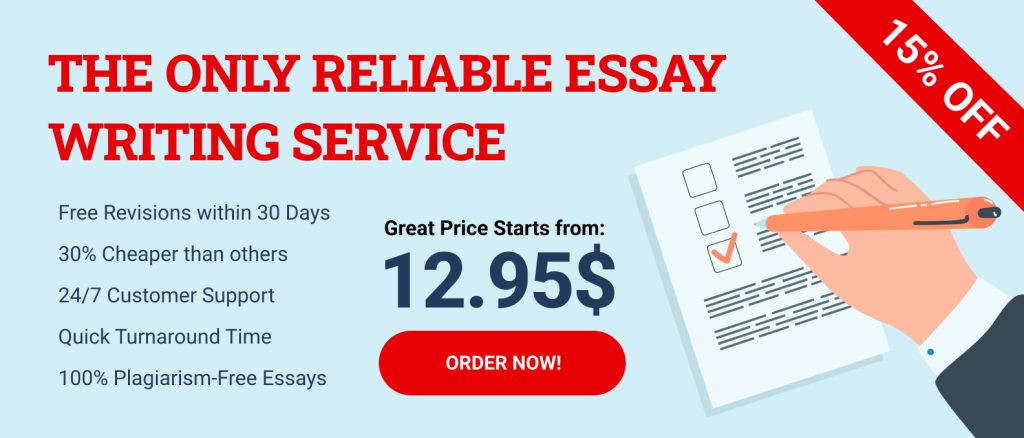
For students who have an essay assignment due in one hour, Type 5: Descriptive can be used to provide a detailed description of their topic so that they can convey their message clearly and effectively within the short timeline.
The five-paragraph essay is one of the most common forms students use in academic writing. It consists of an introduction paragraph, three main body paragraphs, and a conclusion paragraph. Each section serves its purpose in conveying your ideas effectively to the reader. The introduction will provide background information and state your thesis statement; each body paragraph will explore evidence that supports your argument; then finally the concluding paragraph will summarize your evidence and support for your thesis statement.
By taking these steps beforehand, you can ensure that you have all the necessary building blocks for an effective essay before diving into writing it within a limited time frame such as one hour.
As you now understand essays and types, we can dive into techniques, how to write a five-paragraph essay in one hour.
Step 1. Focus your Essay on a Single Topic
In order to focus your essay on a single topic, it is important to first identify the main points that you want to make. After narrowing down your focus, it is also helpful to create an outline of your essay so that you can stay organized and avoid overlap in your argumentation. Finally, be sure to select specific examples and case studies that support your points and help illustrate why they are important.
- Do your research and come up with a clear thesis statement. Research relevant information and facts about your chosen topic to develop an original and interesting thesis statement.
- Create an outline of your essay. List the main points and evidence you’ll be discussing in each section of your essay. This will help you focus on one particular topic and make sure that each part of your essay contributes to its overall message.
- Structure your paragraphs logically. Make sure each paragraph is focused on one idea or point that connects back to the main argument or thesis of your essay. This will help keep the reader’s attention on the single topic of your essay throughout its duration
- Edit, edit, edit Read through your essay several times until you are certain that it is thoroughly well written and focused on one central theme or argument throughout.
Step 2: Outline Your Essay
Writing an essay in one hour can be daunting, but it is certainly achievable with the right mindset and strategies. To help you write your essay in the time allotted, here are several tips on how to outline your essay.
First and foremost, set yourself up for success by taking some time to research or familiarize yourself with the topic at hand. This will help you create an essential structure for your essay so that you can easily maneuver through it later when writing. Additionally, ensure that you have your supporting evidence ready and organized before beginning to write. This will save time in searching for sources during the writing process.
Once you have done some preliminary research and compiled any resources or materials necessary for writing, create an outline of ideas and topics that need to be discussed throughout your essay.
Step 3: Research
How to prevent yourself from giving up halfway through the essay? Ask yourself how can I write my essay in one hour. it seems difficult and impossible, but it is possible with careful preparation and research. Properly researching the topic of your essay is essential for success, no matter how quickly you need to finish your assignment. You can complete the job efficiently and quickly with a few simple steps.
First, take the time to thoroughly read through your prompt and break it down into manageable parts. It’s essential to understand what exactly is being asked of you so that you save time writing about something irrelevant or off-topic. Once you have a clear idea of what kind of response is expected from the essay, begin by skimming over primary sources such as books or articles related to your topic; this will give you an overview of the main points that need to be addressed in your paper.
Step 4: Write the Introduction
The introduction is an important part of writing an essay in one hour. The essay should be concise and give the reader an overview of your main argument. It should include a brief description of what you will be discussing, any background information necessary for understanding the topic, and a thesis statement that explains your point of view. To ensure this step goes smoothly, it’s essential to plan ahead by brainstorming ideas related to your topic before you begin writing. Additionally, make sure that you use clear language and avoid unnecessary jargon or overly-technical terms that could confuse readers.. It serves to capture the reader’s attention and provide a brief overview of the topic. It should include a thesis statement at the end, which will be your main argument or opinion. Additionally, it should provide some context for the rest of the essay and explain why you are discussing the given topic. By taking the time to craft a well-written introduction, you can set yourself up for success in completing your essay in one hour’s time.
Step 5: Write Main Body
Writing an essay in one hour can be a daunting task. However, following a few simple steps can make the process much easier and faster. Step 3 of writing an essay in one hour is to write the main body of your essay. This will be where you explain your thesis statement and provide any evidence or quotes that support it.
It’s important to make sure that your paragraphs are well-organized and easy to read, as this will help you get your point across effectively in the limited time frame. Start each paragraph with a topic sentence that introduces the paragraph’s main idea, then use supporting evidence or examples to develop that idea further. Make sure there is a clear flow between each paragraph so they move logically from one point to the next. Additionally, ensure that all your points are connected back to your overall argument to strengthen its credibility with readers.
Step 6: Write the Conclusion
No essay can be written without a conclusion. For those who are pressed for time and need to complete their essay in one hour, the conclusion should take just a short time to write. It is important to remember that the conclusion should reiterate the main point of the argument, as well as underscore the significance of this point.
The first step when writing a conclusion is to review what has already been discussed in the body of the essay. This helps bring all points together and ensure that everything said ties into one another. The concluding paragraph should then provide an overview of these points, highlighting how they are related and connected. Furthermore, it is advised that authors provide some type of call-to-action or thought-provoking insight in order to leave a lasting impression on readers.
Write a Conclusion in 3 Easy Steps
Step 1: Restate Thesis
Step 2: Summarize the Main Points
Step 3: Conclude with Impact
Step 7 : Edit and Proofread
Editing and proofreading are essential steps in the writing process, no matter the deadline. Due to time constraints, the editing and proofreading stages may be sacrificed when you need to write an essay within one hour. However, it’s important to remember that these steps are just as vital as any other step in the writing process.
The best way to ensure your work is polished is by taking a break after you finish writing. Step away from your work completely – give yourself at least 10-15 minutes before you begin editing and proofreading. This allows your brain to reset so that when you return to your paper, you can view it with fresh eyes and easily identify mistakes that need correction or improvement.
FINAL THOUGHTS:
In conclusion, writing a five-paragraph essay in one hour can be achieved through careful time management and effective planning. To make the task manageable, break down the essay into its four components: introduction, three body paragraphs, and conclusion. For each element, decide on the main idea or point you want to make and how you will present it. Finally, take your time to proofread the essay for errors before submitting it.

IMAGES
VIDEO
COMMENTS
So when it comes to memorising the whole thing, it's a lot easier to break the answer down into logical chunks and work on memorising it bit by bit. So if you want to memorise your Discovery Essay, you might have something like this: Introduction. Theme 1 with the assigned text. Theme 1 with the related text. Theme 2 with the assigned text.
3. Combine the first chunk with the second chunk. Once you have a handle on your chunks, it's time to put them together so you can eventually memorize the whole text. Start with the first text and try to recite it from memory. But this time, instead of stopping with the first chunk, move on to the second chunk.
Learning Each Part of the Essay. Download Article. 1. Make a schedule. Plan out how long you have to memorize the essay. If you have more time, you can study a little each day for 20 or 30 minutes. If you only have a day or 2, you can memorize it in 30-minute chunks with a break of an hour or 2 in between. [1] 2.
Hi guys, welcome to the Academic Hacker!! Today, I'll be going through with you guys the best way to memorise essays in one day more quickly and effectively ...
When you want to remember the words, walk through the same path in your mind and you'll easily recall the words. You can do 3000 words that way, but it's hard for a beginner. I think you should pick one or two words for each line, and reduce the words that way. So your words might probably go from 3000 -> 250. Try it, it works.
The Link and Story Method. 3. The Memory Palace Method. 5 Step 4. Apply Spaced Repetition. 6 Summary: How to Memorize Quickly. 7 Learn More. It's not too difficult to learn how to memorize fast and easily - if you use the right strategies, that is. But most people don't use the right strategies.
2. The Memorisation Stage. Objective of committing all of these essay plans to memory by systematically using active recall, spaced repetition, spider diagrams and flashcards. The idea is that, by using these two stages, by the time the exams arrive you'll have memorised so many essay plans that they will either come up in the exam or the ...
how to memorise long pieces of writing (essays, speeches, extended answers, creative writing, literally anything) and how to use all of the channels of memor...
Even if it is only one night left before exams, students still have good chance to learn the essay fast if they know where to start and which method to apply. Some people memorise information better when they listen to it. Others prefer writing something down to remember it. Finally, for some people re-reading the text multiple times is the ...
1 Make a schedule. Plan out how long you have to memorize the essay. If you have more time, you can study a little each day for 20 or 30 minutes. If you only have a day or 2, you can memorize it in 30-minute chunks with a break of an hour or 2 in between. [1] 2 Break the essay down into parts. Memorization is easiest when done in small chunks....
Note: British/Australian spelling of memorize is "memorise" In this short film, Shay shares his top 3 study tips in regards to memorising lots of information...
3. Repeat and memorize your sentence or image then practice producing the items you've memorized from your sentence or image. You'll use your sentence or image as a key that will bring up what you've memorized. Peanut butter and espresso bean sandwich wrapped in ethernet cable with a screwdriver going through it. =.
Use these tactics to get how to memorize an essay overnight. If you have a whole day to memorize an essay, it is possible to get the entire text provided that you have the level of dedication and hard work required. The time you have is adequate in this case. The key is to ensure that you have a clear mind before you begin.
I highly doubt your professor intended for you to pre-write and memorize the essays prior to the test. The goal here is not to teach you to memorize, but to synthesize information. Think about the main points of your essays and write them at test time. 10. make-that-monet.
Dot points are usually the best way to go, and I always found it good to break them up paragraph by paragraph. This means you should end up with 4-5 dot points* per paragraph, making 16-20 dot points overall - way less than what you'd need to memorise HSC essays in full. Disclaimer: If you have more than one quote per paragraph (which you ...
2. Relax Yourself. The second tip on how to memorize your speech quickly is relaxation. It can help if you are willing to let go of too many expectations for yourself. The more relaxed you are in preparing and memorizing, the more you can effectively assess how your speaking engagement will be.
Hi Guys, How do you memorise essays? just by repetition? Well this video shows you a more effective and fun way to memorise your essays. Stay Connecte...
We will continue on to that next. This is going to structure our research blocks so that we will not wander off-topic. We need to save every single second we can, so staying on task is essential. Step 2 - 15 minutes - Research and outline the body paragraphs. There are generally 3 body paragraphs in a 500-word essay.
Visualize the outline: An outline is composed of organizational patterns of your choosing. Create mental images of your key points in the order you want them in the "story". Those body paragraphs mentioned before are the key points that drive your speech. To memorize them, you can write them as bullet points. For example:
Let's take a look at four tips to help you prepare for the long night. #1. Plan your time. Time management is a high priority when you have only a few hours to write your essay. Thus, use your maximum efficiency and your fullest potential to complete the essay on time.
The introduction of the essay should have a hook. It can be a single or a couple of sentences in the opening to lure the readers in. After the hook, writers should provide the background information or context of the problem or issue. In the closing lines of the introduction, writers should put down the thesis statement.
Stuck with a deadline looming? Find out how to write an essay in an hour in this quick video. I walk you through the essay writing process step by step to ...
Step 5: Write Main Body. Writing an essay in one hour can be a daunting task. However, following a few simple steps can make the process much easier and faster. Step 3 of writing an essay in one hour is to write the main body of your essay. This will be where you explain your thesis statement and provide any evidence or quotes that support it.